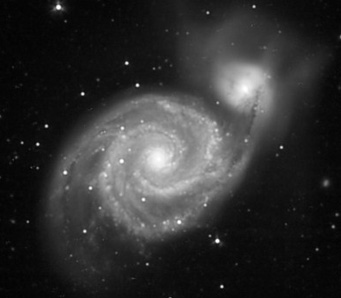Have you ever wanted to process deep-sky data recorded from one of NASA's space probes? Well, now you have a perfect opportunity.
The EPOXI mission (formerly called Deep Impact) recently underwent an "operational training exercise" to bring new team members up to speed on using its cameras by commanding the spacecraft to image a few deep-sky targets. This week, the mission's scientists decided to make all the raw data available to the public as a fun challenge to visitors.
These data include images recorded through spectral filters useful for planetary science. Here's a quick list of the spectral passbands, provided by Planetary Society blogger Emily Lakdawalla:

The Whirlpool Galaxy, Messier 51, as imaged by NASA's EPOXI spacecraft.
NASA / JPL-Caltech / UMD, processed by Sean Walker
•Filter 1: broadband clear silica, centered at 650 nanometers.
•Filter 2: narrowband, centered at 514 nm.
•Filter 4: mediumband, 700-800 nm.
•Filter 5: mediumband, 900-1,000 nm.
•Filter 7: narrowband, centered at 387 nm.
The spacecraft took multiple exposures of each target through these filters and saved them in FITS format, though you'll have to combine the sub-exposures yourself to try and minimize the copious cosmic-ray hits. The targeted objects include M51, NGC 6960, and M27. You can manipulate the data using the free program Fits Liberator 3.0 or any program capable of handling FITS files.
When you're done, email your result (or a link to the image on your own website) back to the mission's scientists, and they'll feature their favorites on the EPOXI website. Don't forget to credit the mission for the data by using this minimum credit line: NASA/JPL-Caltech/UMD, processed by you.
 0
0
Comments
You must be logged in to post a comment.